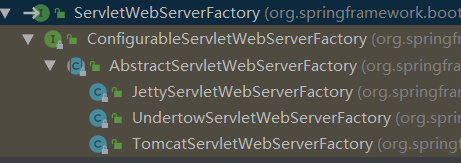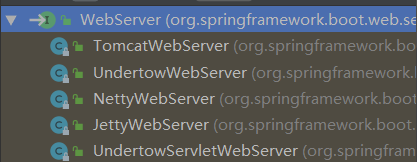SpringBoot8
SpringBoot默认使用Tomcat作为嵌入式的Servlet容器

那么问题来了,我们以前做项目,使用的是外部的tomcat,如果想要修改tomcat,知道本地文件夹中的sever.xml就能修改配置,那么,在使用嵌入式Servlet容器的情况下:
- 如何定制和修改Servlet容器的相关配置;
- SpringBoot能不能支持其他的servlet容器。
1. 定制和修改Servlet容器的相关配置
1.1 在application.properties配置文件中修改
在application.properties配置文件中可以修改与server和tomcat有关的配置
//通用的Servlet容器设置
server.xxx=yyy
server.port=8080
server.context‐path=/crud
//Tomcat的设置
server.tomcat.xxx=yyy
server.tomcat.uri‐encoding=UTF‐8
1.2 在配置类中添加嵌入式的Servlet容器的定制器
在 Spring Boot 1.x 中 ,我们通过 EmbeddedServletContainerCustomizer 接口调优 Tomcat 自定义配置。 在Spring Boot 2.x 中,通过 WebServerFactoryCustomizer 接口定制。
我使用的是SpringBoot2.0以上版本,所以可以编写一个WebServerFactoryCustomizer:嵌入式的Servlet容器的定制器;来修改Servlet容器的配置 ,在MyMvcConfig中添加如下代码
@Bean
public WebServerFactoryCustomizer<TomcatServletWebServerFactory> webServerFactoryCustomizer(){
return new WebServerFactoryCustomizer<TomcatServletWebServerFactory>() {
@Override
public void customize(TomcatServletWebServerFactory factory) {
factory.setPort(8080);
factory.setUriEncoding(Charset.forName("UTF-8"));
}
};
}
2. 注册servlet三大组件
首先新建一个MyServerConfig配置类,用来放置有关server的配置,将前面1.2节中的WebServerFactoryCustomizer添加进来
-
注册servlet
创建MyServlet
public class MyServlet extends HttpServlet { @Override protected void doGet(HttpServletRequest req, HttpServletResponse resp) throws ServletException, IOException { doPost(req, resp); } @Override protected void doPost(HttpServletRequest req, HttpServletResponse resp) throws ServletException, IOException { resp.getWriter().write("Hello MyServlet"); } }添加进MyServerConfig,当访问
/myServlet请求时,页面显示"Hello MyServlet"@Bean public ServletRegistrationBean myServlet(){ ServletRegistrationBean registrationBean = new ServletRegistrationBean(new MyServlet(),"/myServlet"); return registrationBean; } -
注册filter
创建MyFilter
public class MyFilter implements Filter { @Override public void init(FilterConfig filterConfig) throws ServletException { } @Override public void doFilter(ServletRequest servletRequest, ServletResponse servletResponse, FilterChain filterChain) throws IOException, ServletException { System.out.println("MyFilter process..."); } @Override public void destroy() { } }添加进MyServerConfig,拦截到
/hello和/myServlet请求时,控制台打印"MyFilter process…"@Bean public FilterRegistrationBean myFilter(){ FilterRegistrationBean registrationBean = new FilterRegistrationBean(); registrationBean.setFilter(new MyFilter()); registrationBean.setUrlPatterns(Arrays.asList("/hello","/myServlet")); return registrationBean; } -
注册listener
创建MyListener
public class MyListener implements ServletContextListener { @Override public void contextInitialized(ServletContextEvent sce) { System.out.println("contextInitialized...web应用启动"); } @Override public void contextDestroyed(ServletContextEvent sce) { System.out.println("contextDestroyed...当前web项目销毁"); } }添加进MyServerConfig,当项目启动和销毁时,控制台显示不同的输出。
@Bean public ServletListenerRegistrationBean myListener(){ ServletListenerRegistrationBean<MyListener> registrationBean = new ServletListenerRegistrationBean<>(new MyListener()); return registrationBean; } -
SpringBoot帮我们配置SpringMVC的时候,自动注册SpringMVC的前端控制器:dispatcherServlet。
在DispatcherServletAutoConfiguration中
@Configuration( proxyBeanMethods = false ) @Conditional({DispatcherServletAutoConfiguration.DispatcherServletRegistrationCondition.class}) @ConditionalOnClass({ServletRegistration.class}) @EnableConfigurationProperties({WebMvcProperties.class}) @Import({DispatcherServletAutoConfiguration.DispatcherServletConfiguration.class}) protected static class DispatcherServletRegistrationConfiguration { protected DispatcherServletRegistrationConfiguration() { } @Bean( name = {"dispatcherServletRegistration"} ) @ConditionalOnBean( value = {DispatcherServlet.class}, name = {"dispatcherServlet"} ) public DispatcherServletRegistrationBean dispatcherServletRegistration(DispatcherServlet dispatcherServlet, WebMvcProperties webMvcProperties, ObjectProvider<MultipartConfigElement> multipartConfig) { DispatcherServletRegistrationBean registration = new DispatcherServletRegistrationBean(dispatcherServlet, webMvcProperties.getServlet().getPath()); registration.setName("dispatcherServlet"); registration.setLoadOnStartup(webMvcProperties.getServlet().getLoadOnStartup()); multipartConfig.ifAvailable(registration::setMultipartConfig); return registration; } }其中
DispatcherServletRegistrationBean registration = new DispatcherServletRegistrationBean(dispatcherServlet, webMvcProperties.getServlet().getPath());为注册的dispatcherServlet。查看webMvcProperties中的方法,可以得到默认拦截的路径为
/,表明会拦截所有请求;包静态资源,但是不拦截jsp请求 。如果拦截路径为/*的话,会拦截jsp请求。public class WebMvcProperties { private final WebMvcProperties.Servlet servlet; public WebMvcProperties.Servlet getServlet() { return this.servlet; } ... public static class Servlet { private String path = "/"; private int loadOnStartup = -1; public String getPath() { return this.path; } ... }
3. 切换其他嵌入式Servlet容器
在SpringBoot中,有三种嵌入式Servlet容器,分别为:tomcat、jetty、undertow。
tomcat为默认方式;jetty适用于长连接,比如说聊天场景;undertow不支持jsp
要切换其他容器,只需要在pom文件中,把tomcat排除,添加要使用的容器的依赖即可
<!‐‐排除tomcat容器‐‐>
<dependency>
<groupId>org.springframework.boot</groupId>
<artifactId>spring‐boot‐starter‐web</artifactId>
<exclusions>
<exclusion>
<artifactId>spring‐boot‐starter‐tomcat</artifactId>
<groupId>org.springframework.boot</groupId>
</exclusion>
</exclusions>
</dependency>
<!‐‐引入其他的Servlet容器,以jetty为例‐‐>
<dependency>
<artifactId>spring‐boot‐starter‐jetty</artifactId>
<groupId>org.springframework.boot</groupId>
</dependency>
4. 嵌入式Servlet容器自动配置原理
org.springframework.boot.autoconfigure.web.embedded.EmbeddedWebServerFactoryCustomizerAutoConfiguration自动配置嵌入式servlet容器,其详细代码如下所示:
@Configuration(
proxyBeanMethods = false
)
//运行在web应用中,条件成立
@ConditionalOnWebApplication
@EnableConfigurationProperties({ServerProperties.class})
public class EmbeddedWebServerFactoryCustomizerAutoConfiguration {
public EmbeddedWebServerFactoryCustomizerAutoConfiguration() {
}
//配置Netty
@Configuration(
proxyBeanMethods = false
)
//当类HttpServer.class存在时,条件成立。引入依赖,这个类就会存在
@ConditionalOnClass({HttpServer.class})
public static class NettyWebServerFactoryCustomizerConfiguration {
public NettyWebServerFactoryCustomizerConfiguration() {
}
@Bean
public NettyWebServerFactoryCustomizer nettyWebServerFactoryCustomizer(Environment environment, ServerProperties serverProperties) {
return new NettyWebServerFactoryCustomizer(environment, serverProperties);
}
}
//配置Undertow
@Configuration(
proxyBeanMethods = false
)
@ConditionalOnClass({Undertow.class, SslClientAuthMode.class})
public static class UndertowWebServerFactoryCustomizerConfiguration {
public UndertowWebServerFactoryCustomizerConfiguration() {
}
@Bean
public UndertowWebServerFactoryCustomizer undertowWebServerFactoryCustomizer(Environment environment, ServerProperties serverProperties) {
return new UndertowWebServerFactoryCustomizer(environment, serverProperties);
}
}
//配置Jetty
@Configuration(
proxyBeanMethods = false
)
@ConditionalOnClass({Server.class, Loader.class, WebAppContext.class})
public static class JettyWebServerFactoryCustomizerConfiguration {
public JettyWebServerFactoryCustomizerConfiguration() {
}
@Bean
public JettyWebServerFactoryCustomizer jettyWebServerFactoryCustomizer(Environment environment, ServerProperties serverProperties) {
return new JettyWebServerFactoryCustomizer(environment, serverProperties);
}
}
//配置tomcat
@Configuration(
proxyBeanMethods = false
)
@ConditionalOnClass({Tomcat.class, UpgradeProtocol.class})
public static class TomcatWebServerFactoryCustomizerConfiguration {
public TomcatWebServerFactoryCustomizerConfiguration() {
}
@Bean
public TomcatWebServerFactoryCustomizer tomcatWebServerFactoryCustomizer(Environment environment, ServerProperties serverProperties) {
return new TomcatWebServerFactoryCustomizer(environment, serverProperties);
}
}
}
-
ServletWebServerFactory:容器工厂,其代码如下所示
public interface ServletWebServerFactory { //获取嵌入式的servlet容器 WebServer getWebServer(ServletContextInitializer... initializers); }
-
嵌入式servlet容器

-
以TomcatServletWebServerFactory为例
public class TomcatServletWebServerFactory extends AbstractServletWebServerFactory implements ConfigurableTomcatWebServerFactory, ResourceLoaderAware { ... public WebServer getWebServer(ServletContextInitializer... initializers) { if (this.disableMBeanRegistry) { Registry.disableRegistry(); } //创建一个tomcat Tomcat tomcat = new Tomcat(); //配置tomcat的基本环境 File baseDir = this.baseDirectory != null ? this.baseDirectory : this.createTempDir("tomcat"); tomcat.setBaseDir(baseDir.getAbsolutePath()); Connector connector = new Connector(this.protocol); connector.setThrowOnFailure(true); tomcat.getService().addConnector(connector); this.customizeConnector(connector); tomcat.setConnector(connector); tomcat.getHost().setAutoDeploy(false); this.configureEngine(tomcat.getEngine()); Iterator var5 = this.additionalTomcatConnectors.iterator(); while(var5.hasNext()) { Connector additionalConnector = (Connector)var5.next(); tomcat.getService().addConnector(additionalConnector); } this.prepareContext(tomcat.getHost(), initializers); //将配置好的tomcat传进去 return this.getTomcatWebServer(tomcat); } //返回一个TomcatWebServer protected TomcatWebServer getTomcatWebServer(Tomcat tomcat) { return new TomcatWebServer(tomcat, this.getPort() >= 0); } }//并启动tomcat服务器
public TomcatWebServer(Tomcat tomcat, boolean autoStart) { this.monitor = new Object(); this.serviceConnectors = new HashMap(); Assert.notNull(tomcat, "Tomcat Server must not be null"); this.tomcat = tomcat; this.autoStart = autoStart; this.initialize(); } -
我们对嵌入式容器的配置修改是怎么生效
有两种方式:
- 在application.properties中修改
- 添加WebServerFactoryCustomizer到配置类
这两种方式归根结底,其实都是修改的
ServerProperties中的值@ConfigurationProperties( prefix = "server", ignoreUnknownFields = true ) public class ServerProperties { private Integer port; private InetAddress address; ... }从上述代码可以看出,在application.properties中,以
server开头的配置,是对ServerProperties的属性进行了修改而TomcatServletWebServerFactoryCustomizer中的所有方法也都是围绕它的唯一属性ServerProperties来展开的。
public class TomcatServletWebServerFactoryCustomizer implements WebServerFactoryCustomizer<TomcatServletWebServerFactory>, Ordered { private final ServerProperties serverProperties; public TomcatServletWebServerFactoryCustomizer(ServerProperties serverProperties) { this.serverProperties = serverProperties; } ... } -
容器配置修改的原理:
容器中导入了 WebServerFactoryCustomizerBeanPostProcessor
public class WebServerFactoryCustomizerBeanPostProcessor implements BeanPostProcessor, BeanFactoryAware { private ListableBeanFactory beanFactory; private List<WebServerFactoryCustomizer<?>> customizers; public WebServerFactoryCustomizerBeanPostProcessor() { } public void setBeanFactory(BeanFactory beanFactory) { Assert.isInstanceOf(ListableBeanFactory.class, beanFactory, "WebServerCustomizerBeanPostProcessor can only be used with a ListableBeanFactory"); this.beanFactory = (ListableBeanFactory)beanFactory; } public Object postProcessBeforeInitialization(Object bean, String beanName) throws BeansException { //如果当前初始化的是一个WebServerFactory类型的组件 if (bean instanceof WebServerFactory) { this.postProcessBeforeInitialization((WebServerFactory)bean); } return bean; } public Object postProcessAfterInitialization(Object bean, String beanName) throws BeansException { return bean; } private void postProcessBeforeInitialization(WebServerFactory webServerFactory) { //获取所有的定制器,调用每一个定制器的customize方法来给Servlet容器进行属性赋值 ((Callbacks)LambdaSafe.callbacks(WebServerFactoryCustomizer.class, this.getCustomizers(), webServerFactory, new Object[0]).withLogger(WebServerFactoryCustomizerBeanPostProcessor.class)).invoke((customizer) -> { customizer.customize(webServerFactory); }); } private Collection<WebServerFactoryCustomizer<?>> getCustomizers() { if (this.customizers == null) { this.customizers = new ArrayList(this.getWebServerFactoryCustomizerBeans()); this.customizers.sort(AnnotationAwareOrderComparator.INSTANCE); this.customizers = Collections.unmodifiableList(this.customizers); } return this.customizers; } private Collection<WebServerFactoryCustomizer<?>> getWebServerFactoryCustomizerBeans() { return this.beanFactory.getBeansOfType(WebServerFactoryCustomizer.class, false, false).values(); } }定制器会修改ServerProperties
-
嵌入式Servlet容器自动配置的顺序
- SpringBoot根据导入的依赖情况,给容器中添加相应的ServletWebServerFactory,如TomcatServletWebServerFactory
- 容器中某个组件要创建对象就会惊动后置处理器WebServerFactoryCustomizerBeanPostProcessor,只要是嵌入式的Servlet容器工厂,后置处理器就工作
- 后置处理器,从容器中获取所有的WebServerFactoryCustomizer,调用定制器的定制方法
5. 使用外部servlet容器
嵌入式Servlet容器:将应用打成可执行的jar包
- 优点:简单、便捷
- 缺点:默认不支持JSP、优化定制比较复杂(使用定制器、自己编写嵌入式Servlet容器的创建工厂 )
外置的Servlet容器:可以将应用以war包的方式打包
步骤:
-
必须创建一个war项目(利用IDEA创建好目录结构),详细步骤在后面
-
在pom文件中将嵌入式的Tomcat指定为provided
<dependency> <groupId>org.springframework.boot</groupId> <artifactId>spring-boot-starter-tomcat</artifactId> <scope>provided</scope> </dependency> -
必须编写一个SpringBootServletInitializer的子类,并调用configure方法

-
启动服务器就可以使用
创建war项目且实现jsp功能的详细步骤



创建项目以后,打开project settings使用idea自动生成webapp目录

将web.xml文件放入src\main\webapp\WEB-INF文件夹中

目录结构如下

添加本地tomcat服务器

把要部署的项目添加进来

上述步骤完成之后,在webapp下创建hello.jsp,启动tomat服务器,地址栏输入localhost:8080/hello.jsp就能正常访问了。jsp功能实现了。
下面实现sprngmvc功能
在webapp\WEB-INF目录下创建success.jsp
<%@ page contentType="text/html;charset=UTF-8" language="java" %>
<html>
<head>
<title>$Title$</title>
</head>
<body>
<h1>success</h1>
<h3>${msg}</h3>
</body>
</html>
创建controller.HelloController
@Controller
public class HelloController {
@GetMapping("/abc")
public String hello(Model model){
model.addAttribute("msg","你好");
return "success";
}
}
在application.properties文件中配置前缀和后缀
spring.mvc.view.prefix=/WEB-INF/
spring.mvc.view.suffix=.jsp
重新启动服务器,在地址栏输入localhost:8080/abc即可访问success页面,并且也能获取到msg的值






















 696
696

 被折叠的 条评论
为什么被折叠?
被折叠的 条评论
为什么被折叠?








